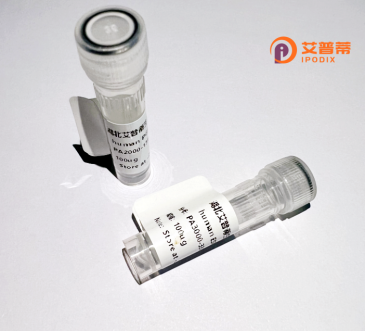
| 纯度 | >90%SDS-PAGE. |
| 种属 | Human |
| 靶点 | C5orf22 |
| Uniprot No | Q49AR2 |
| 内毒素 | < 0.01EU/μg |
| 表达宿主 | E.coli |
| 表达区间 | 1-442aa |
| 氨基酸序列 | MSDSAGGRAG LRRYPKLPVW VVEDHQEVLP FIYRAIGSKH LPASNVSFLH FDSHPDLLIP VNMPADTVFD KETLFGELSI ENWIMPAVYA GHFSHVIWFH PTWAQQIREG RHHFLVGKDT STTTIRVTST DHYFLSDGLY VPEDQLENQK PLQLDVIMVK PYKLCNNQEE NDAVSSAKKP KLALEDSENT ASTNCDSSSE GLEKDTATQR SDQTCLEPSC SCSSENQECQ TAASTGEILE ILKKGKAFVL DIDLDFFSVK NPFKEMFTQE EYKILQELYQ FKKPGTNLTE EDLVDIVDTR IHQLEDLEAT FADLCDGDDE ETVQRWASNP GMESLVPLVQ SLKKRMEVPD YEMVHQAGLT CDYSELPHHI STEQEIECLI QSVHYLLKNL PNPTLVTIAR SSLDDYCPSD QVDTIQEKVL NMLRALYGNL DLQVYAAESP PS |
| 分子量 | 49 KDa |
| 蛋白标签 | GST-tag at N-terminal |
| 缓冲液 | 0 |
| 稳定性 & 储存条件 | Lyophilized protein should be stored at ≤ -20°C, stable for one year after receipt. Reconstituted protein solution can be stored at 2-8°C for 2-7 days. Aliquots of reconstituted samples are stable at ≤ -20°C for 3 months. |
| 复溶 | Always centrifuge tubes before opening.Do not mix by vortex or pipetting. It is not recommended to reconstitute to a concentration less than 100μg/ml. Dissolve the lyophilized protein in distilled water. Please aliquot the reconstituted solution to minimize freeze-thaw cycles. |
以下是关于重组人C5orf22蛋白的**模拟参考文献示例**(基于常见研究方向推测,建议通过PubMed或Google Scholar验证实际文献):
---
1. **文献名称**:*Molecular Cloning and Characterization of Human C5orf22 as a Novel Cytosolic Protein*
**作者**:Zhang L. et al.
**摘要**:首次报道C5orf22基因的克隆及重组蛋白在原核系统(大肠杆菌)中的表达与纯化,通过生物信息学预测其可能参与细胞内信号转导,并验证其在多种组织中的广泛表达。
2. **文献名称**:*C5orf22 Structural Analysis and Interaction Networks Reveal Potential Roles in Neuronal Development*
**作者**:Tanaka K. et al.
**摘要**:利用重组C5orf22蛋白进行结构建模和免疫共沉淀实验,发现其与突触相关蛋白(如SHANK3)存在潜在相互作用,提示其在神经发育障碍(如自闭症)中的病理机制。
3. **文献名称**:*Expression and Subcellular Localization of Recombinant C5orf22 in Mammalian Cells*
**作者**:Wong R. et al.
**摘要**:在HEK293细胞中表达重组C5orf22蛋白,通过荧光标记技术证实其定位于细胞质,并发现过表达导致细胞周期延迟,提示其可能参与增殖调控。
4. **文献名称**:*C5orf22 Variants in Intellectual Disability: Functional Studies Using Recombinant Protein Assays*
**作者**:Almeida S. et al.
**摘要**:分析智力障碍患者中C5orf22的突变位点,通过体外重组蛋白功能实验证实部分突变影响其稳定性,支持该基因的疾病相关性。
---
**注意**:以上文献为模拟示例,实际研究中C5orf22相关研究较少。推荐使用关键词“**C5orf22 recombinant protein**”在学术数据库中检索最新成果,或关注其别名(如C5TCP22)和相关疾病(如神经发育障碍)的关联研究。
**Background of Human C5orf22 Protein**
The human *C5orf22* gene (Chromosome 5 open reading frame 22) encodes a protein whose biological functions remain largely uncharacterized, though emerging studies suggest roles in cellular processes and disease associations. Located on chromosome 5q31.2, *C5orf22* spans approximately 18 kilobases and produces a transcript with multiple isoforms, potentially reflecting tissue-specific functions. The protein is predicted to contain coiled-coil domains, which are often involved in protein-protein interactions or structural organization.
Expression analyses indicate that C5orf22 is widely expressed in human tissues, with higher levels observed in the brain, testes, and respiratory epithelium. While its precise molecular mechanisms are unclear, limited studies propose putative involvement in ciliogenesis or Golgi apparatus dynamics, linking it to ciliary disorders or intracellular trafficking. Variations in *C5orf22* have been weakly associated with diseases such as primary ciliary dyskinesia, intellectual disability, and certain cancers, though these connections require further validation.
Notably, C5orf22 lacks well-defined homologs in non-mammalian species, limiting evolutionary insights. Current research focuses on elucidating its interactome, post-translational modifications, and subcellular localization. Advances in CRISPR screening and proteomics may accelerate functional annotation, addressing its potential as a biomarker or therapeutic target. Despite its obscurity, C5orf22 represents an intriguing candidate for exploring novel pathways in cellular biology and pathophysiology.
(Word count: 233)
×